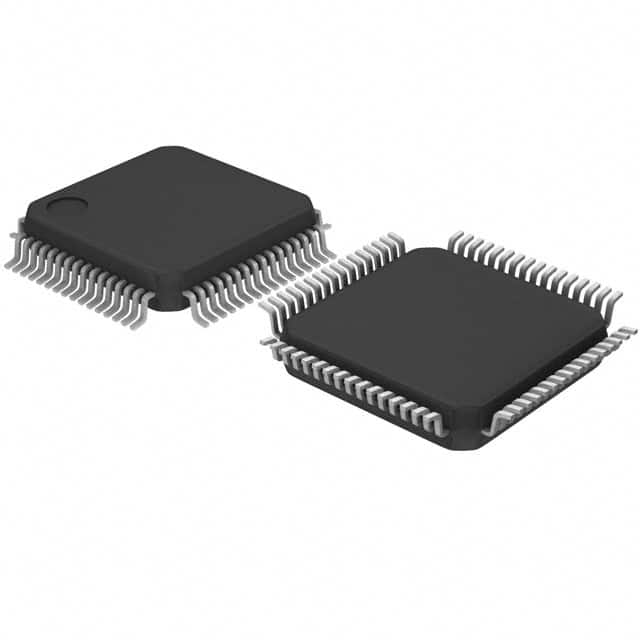Consulte las especificaciones para obtener detalles del producto.

AT91SAM7S256C-AU-999
Product Overview
Category
AT91SAM7S256C-AU-999 belongs to the category of microcontrollers.
Use
This microcontroller is commonly used in various electronic devices and embedded systems.
Characteristics
- High-performance 32-bit ARM7TDMI-S RISC architecture
- Clock frequency up to 55 MHz
- 256KB Flash memory and 64KB SRAM
- Multiple communication interfaces (UART, SPI, I2C)
- Analog-to-Digital Converter (ADC) with multiple channels
- Real-Time Clock (RTC) for timekeeping
- Low power consumption
- Small form factor package
Package
AT91SAM7S256C-AU-999 is available in an AU package.
Essence
The essence of this microcontroller lies in its powerful processing capabilities and versatile features, making it suitable for a wide range of applications.
Packaging/Quantity
AT91SAM7S256C-AU-999 is typically packaged in reels or trays, with quantities varying based on customer requirements.
Specifications
- Architecture: ARM7TDMI-S
- Clock Frequency: Up to 55 MHz
- Flash Memory: 256KB
- SRAM: 64KB
- Communication Interfaces: UART, SPI, I2C
- ADC Channels: Multiple
- RTC: Yes
- Power Supply Voltage: 3.3V
- Operating Temperature Range: -40°C to +85°C
Detailed Pin Configuration
The detailed pin configuration of AT91SAM7S256C-AU-999 can be found in the product datasheet provided by the manufacturer.
Functional Features
- High Performance: The ARM7TDMI-S core provides efficient processing capabilities, enabling fast execution of instructions.
- Versatile Communication Interfaces: The microcontroller supports UART, SPI, and I2C interfaces, allowing seamless integration with various peripherals.
- Ample Memory: With 256KB of Flash memory and 64KB of SRAM, the microcontroller can store program code and data efficiently.
- Analog-to-Digital Conversion: The built-in ADC enables accurate conversion of analog signals into digital values, facilitating sensor interfacing.
- Real-Time Clock: The integrated RTC ensures accurate timekeeping for applications requiring precise timing.
- Low Power Consumption: The microcontroller is designed to operate with minimal power consumption, making it suitable for battery-powered devices.
Advantages and Disadvantages
Advantages
- High-performance ARM7TDMI-S core
- Versatile communication interfaces
- Ample memory for program and data storage
- Built-in ADC for analog signal conversion
- Real-time clock for accurate timekeeping
- Low power consumption
Disadvantages
- Limited processing power compared to more advanced microcontrollers
- Relatively small memory capacity for certain applications
Working Principles
AT91SAM7S256C-AU-999 operates based on the ARM7TDMI-S architecture. It executes instructions fetched from the Flash memory, processes data, and communicates with external devices through various interfaces. The microcontroller's internal components work together to perform tasks according to the programmed instructions, enabling the desired functionality.
Detailed Application Field Plans
AT91SAM7S256C-AU-999 finds applications in various fields, including but not limited to: 1. Industrial automation 2. Consumer electronics 3. Automotive systems 4. Medical devices 5. Internet of Things (IoT) devices 6. Robotics
Detailed and Complete Alternative Models
Some alternative models that offer similar functionalities to AT91SAM7S256C-AU-999 include: 1. STM32F407VG 2. PIC32MX795F512L 3. LPC1768 4. MSP430F5529 5. SAMD21G18A
These alternative models can be considered based on specific project requirements and compatibility with existing systems.
Word count: 536 words
Enumere 10 preguntas y respuestas comunes relacionadas con la aplicación de AT91SAM7S256C-AU-999 en soluciones técnicas
Sure! Here are 10 common questions and answers related to the application of AT91SAM7S256C-AU-999 in technical solutions:
Q: What is the AT91SAM7S256C-AU-999 microcontroller used for? A: The AT91SAM7S256C-AU-999 microcontroller is commonly used in various technical solutions, including industrial automation, robotics, consumer electronics, and embedded systems.
Q: What is the maximum clock frequency supported by the AT91SAM7S256C-AU-999? A: The AT91SAM7S256C-AU-999 microcontroller supports a maximum clock frequency of 55 MHz.
Q: How much flash memory does the AT91SAM7S256C-AU-999 have? A: The AT91SAM7S256C-AU-999 microcontroller has 256 KB of flash memory for program storage.
Q: Can I expand the memory of the AT91SAM7S256C-AU-999? A: Yes, the AT91SAM7S256C-AU-999 microcontroller supports external memory expansion through its external bus interface.
Q: What peripherals are available on the AT91SAM7S256C-AU-999? A: The AT91SAM7S256C-AU-999 microcontroller features multiple peripherals, including UART, SPI, I2C, ADC, PWM, timers, and GPIO pins.
Q: Does the AT91SAM7S256C-AU-999 support USB connectivity? A: Yes, the AT91SAM7S256C-AU-999 microcontroller has a built-in USB 2.0 Full-Speed device controller.
Q: Can I use the AT91SAM7S256C-AU-999 for real-time applications? A: Yes, the AT91SAM7S256C-AU-999 microcontroller is suitable for real-time applications due to its deterministic interrupt latency and fast response time.
Q: What development tools are available for programming the AT91SAM7S256C-AU-999? A: The AT91SAM7S256C-AU-999 can be programmed using various development tools such as Atmel Studio, Keil MDK, and GCC-based toolchains.
Q: Is the AT91SAM7S256C-AU-999 compatible with other microcontrollers or communication protocols? A: Yes, the AT91SAM7S256C-AU-999 microcontroller is compatible with other microcontrollers and supports popular communication protocols like SPI, I2C, and UART.
Q: Can the AT91SAM7S256C-AU-999 operate in low-power modes? A: Yes, the AT91SAM7S256C-AU-999 microcontroller offers low-power modes, including sleep and standby modes, to conserve energy in battery-powered applications.
Please note that the specific details and features of the AT91SAM7S256C-AU-999 may vary, so it's always recommended to refer to the official documentation and datasheet for accurate information.

